
 Fokker C.XI W (1934-38)
Fokker C.XI W (1934-38)
About Fokker and Floatplanes
Created by a Dutchman, Anthony Fokker, the company he founded in 1912 in Schwerin, Germany, soon became a legend of aviation, credited with Albatros with providing the best central empires designs of WWI. The Fokker D.VII, his last fighter, was even mentioned in the Armistice clauses and served for many years postwar in other aviations. Fokker managed to create a single floatplane in WWI, the W.3 (W standing for “Wasser”), a version of M.7 (1915). See also the Marineflieger
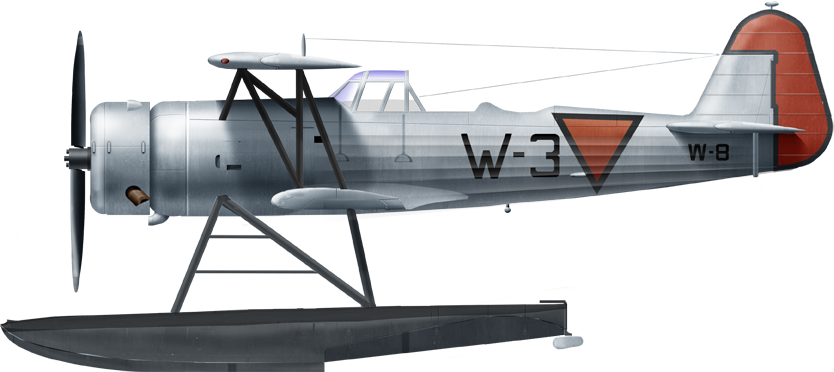
Back in the Netherlands, Anthony Fokker reopened to business, this time venturing into commercial aviation, bringing a line of successful models to the interwar aviation at large. One such models was the 1925 F.VIIa/3m trimotor, used by 54 airlines worldwide with 40% of the American market in 1936. Soon, finances of the company were such that more ambitious ventures were possible. The national company, KLM, wanted to expand its lines and use its links with the Dutch West and East Indies using floatplane version of its land-based models and if needed, newly developed models.
One such models was the Fokker T.IV, an ugly but sturdy twin-engine monoplane, usable for transport but also as torpedo-bomber and for reconnaissance, development from the 1927 T.IV, used as a bomber in the Netherlands East Indies. It used the new Wright Cyclone SR-1820-F2 radial engines instead of Lorraine-Dietrich W-types, an engine choice that became common for Fokker models in the 1930s. Its replacement was the Fokker T.VIII, first flying in 1938. 36 were used by the Marine-Luchtvaartdienst, mostly with the KNIL.
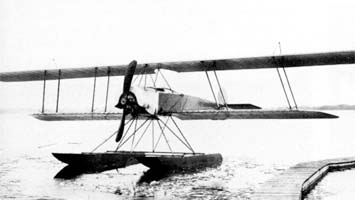
Fokker W.3, 1915
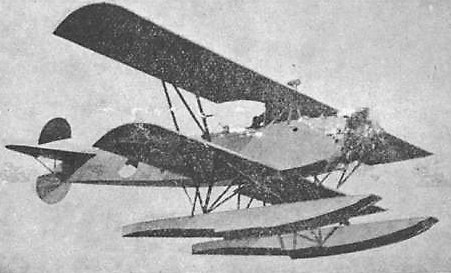
Fokker C.VII W
But these were large, long range models, which did not solved sea-borne operations of the KNIL in the vast expanses of the Pacific. With two cruisers in 1934 (The Java class) and a third coming (De Ruyter), more planned, as well as the Admiralen class destroyers, there was a need for a lighter model, which can be launched by catapult.
The full list included the Fokker B.I & B.III reconnaissance flying boat (1922), B.II – reconnaissance flying boat (1923), B.IV – transport flying boat (1928), C.VII-W – two-seat light reconnaissance/training floatplane (1928), C.VIII-W – three-seat reconnaissance floatplane (1928), the C.XI-W and C.XIV (1937) both two-seat reconnaissance seaplanes covered here, the commercial F.VII airliner, the military T.II three-seat bombing torpedo floatplane (1921), T.III, T.IV seen above and its replacement the T.VIII-W.
Development and Design
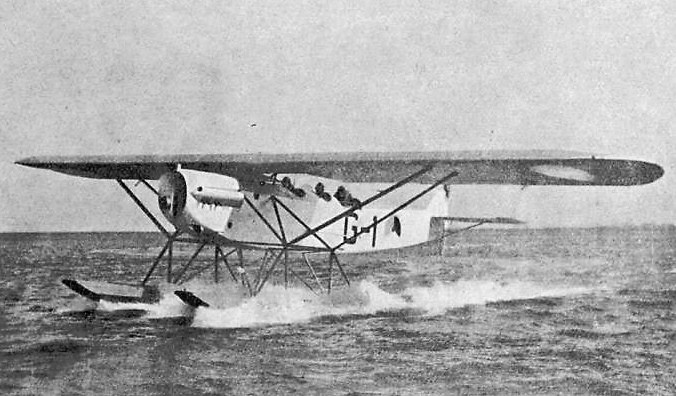
Fokker C.VIII W in 1931
The Java class first operated a B.II without catapult at first, soon replaced by the C.VII W. It was put at sea using the mainmast boom and recovered the same way. But the standard in the Royal Netherlands Navy soon became the Fokker C.VIII-W: With three seats, with an observer for navigation, an tail gunner, it was used both for reconnaissance and artillery spotting.
The C.VIII landplane which first flew in 1928, had an inline Hispano-Suiza 12Lb engine. Only one was built, not adopted for the Royal Netherlands Army Aviation Group. The Navy got interested and soon ordered a floatplane variant (“W”), fitted with a more powerful Lorraine 12E Courlis engine with forward radiator, of which 9 were built. However it was seen as a lumbering beast, underpowered. To face possible encounters with fighter, the Navy looked for a smaller, faster and more agile model.
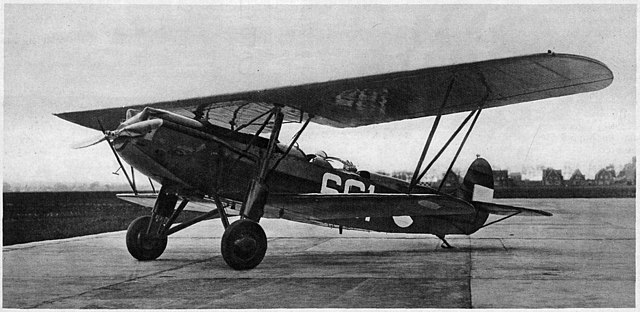
The Fokker C-IX, single-engine biplane reconnaissance and day bomber, credit to be at the origin of the C.XI W.
After the failure of the Fokker C.VIII, the need for a new day reconnaissance bomber was still there, and the need was expressed for two crew members only. Gokker hence developed the C-IX as an improved version of its successful C.V, kept very similar. The latter was however slightly heavier, with a 390 liters tank located behind the engine (upper wing) with two additional 352 liters tanks for a total of 742 liters, maximazing the range. The C-IX had about the same wings and wings area, slightly reinforced shock absorbers for the landing gear. It also had a forward firing light machine gun located in the lower fuselage, for easier access. It was of course synchronized with the propeller.
The Fokker C.IX was powered by a 650 hp Hispano-Suiza inline, liquid-cooled engine, and achieved a flight range of 1050 km and top speed of 235 kph, but the Royal Netherlands Air Force which tested it, declined any order, and instead the model was only sold to the Swiss air force without license agreement, remaining at just 6 delivered.
A derivative of the C.X
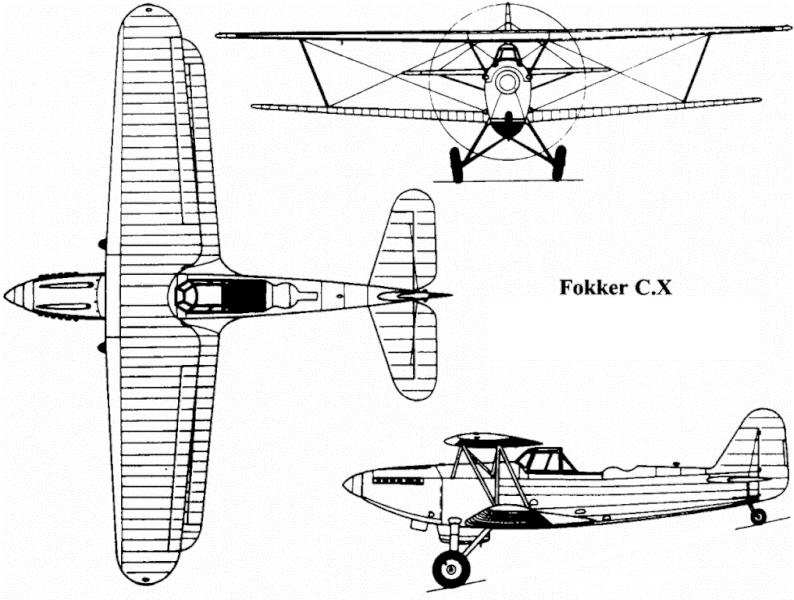
First version with an inline engine. The fine lines are reminiscent of Hawker aircraft of the time. The final version had a radial engine.
With the fiasco of the old-fashioned C.IX, Fokker was summoned to come up with a better model, the next in line, C.X. It was designed at first as a reconnaissance aircraft for the KNIL, but tests were so good, that the Aviation Department wanted it for Strategic Exploration Department (StraVA). It had many modern featires like a semi-enclosed cockpit with open seat behind for the observer/machine gunner and still can carry small bombs, sixteen 25 kg incendiary or HE, or eight of 50 kg or four of 100 kg (so 400 kgs/881 Ibs); not bad for a reconnaissance biplane. It had like all previous models a low-mounted forward firing fixed machine gun and rear one on a flexible mount.
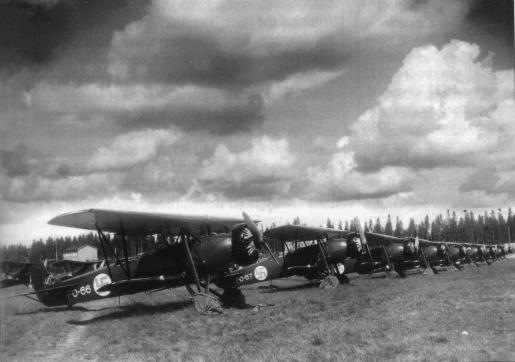
Fokker C.VE in Finnish service
The C.X was powered by a radial Rolls Royce Kestrel V (650 hp) enabling 330 kph top speed and still kept a 830 km range, while it could reach 8,300 m altitude. It was exported to Finland and Spain, fighting on the Republican side during the civil war, 68 built in all. It also fought in the Netherlands in 1940 and the East Indies against the Japanese.
A new floatplane
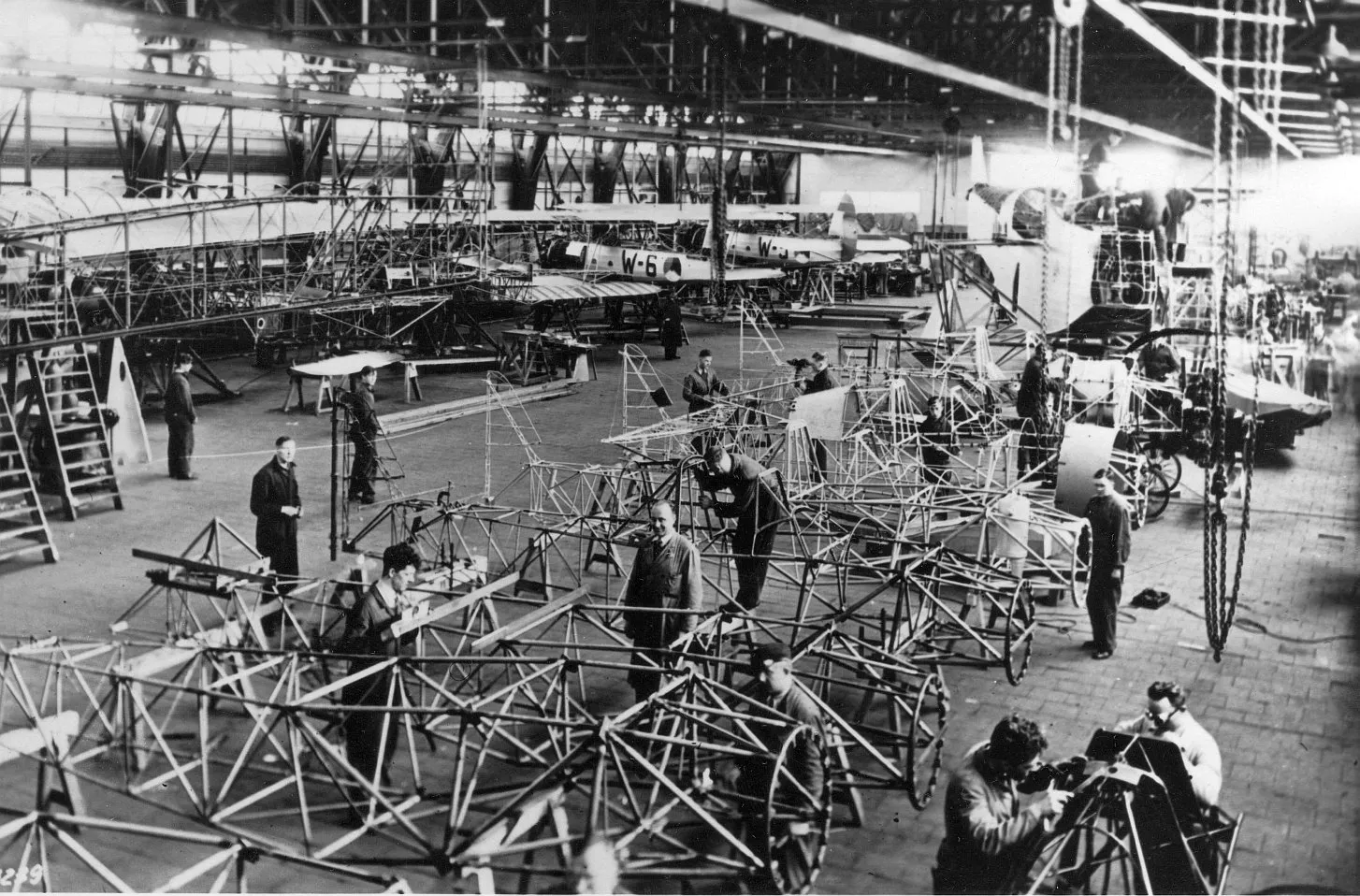
Fokker C.XI production line – src fokker-history.com/
A floatplane variant to be used on ships was developed after an official order from the Navy to Fokker in 1934. The main need was a model to be catapulted from the new cruiser Hr.Ms de Ruyter. Indeed, the previous 1920s Java class operated without catapult, and none would be fitted on the Admiralen class destroyers. But all KNIL ships needed to receive one, as stated by the new policy of the admiralty for the east indies. Fokker just took the successful C.X as base model for inspiration, with the idea of fitting modern metal floats and change the engine for a US radial, easier to maintain in the east Indies.
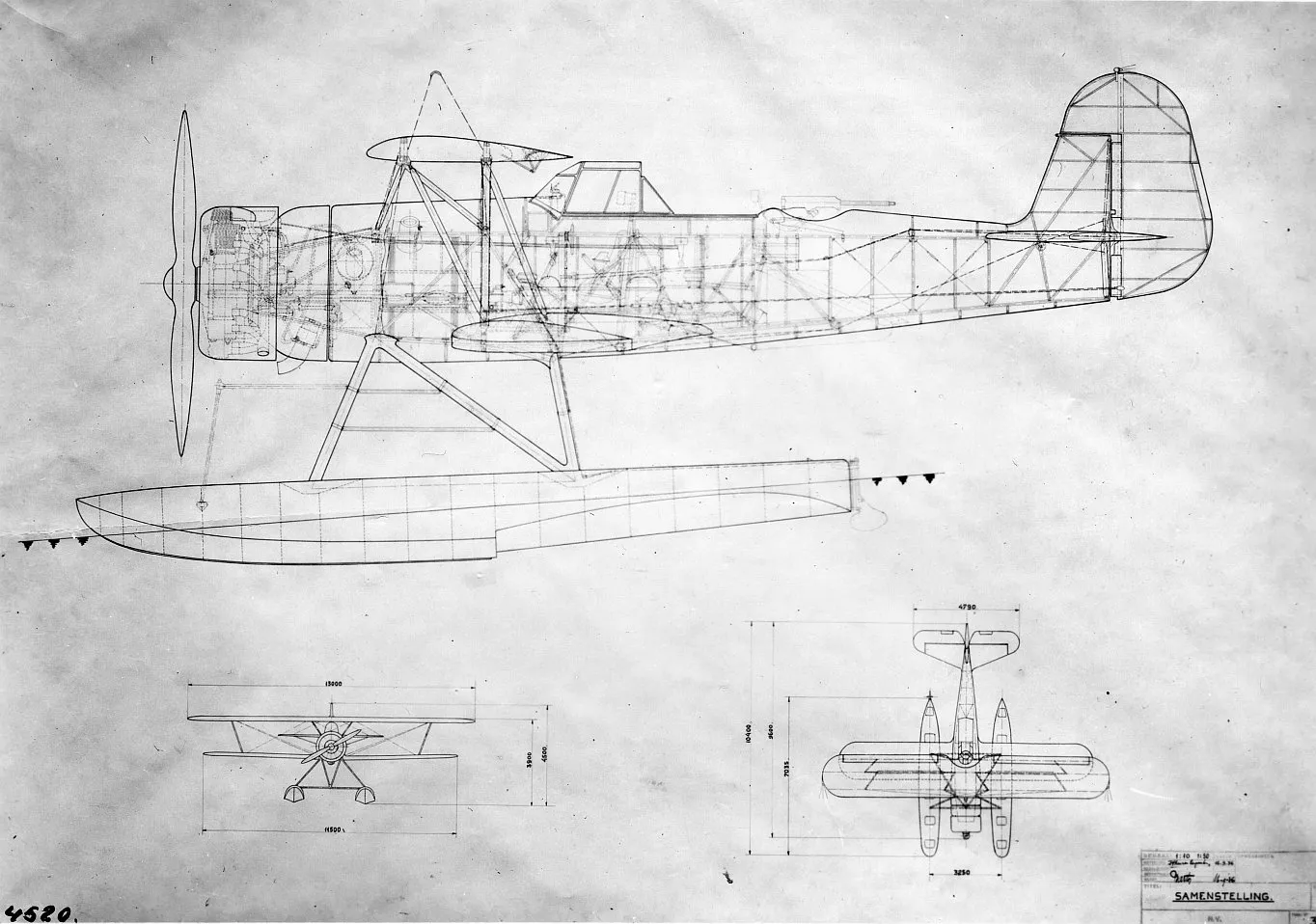
Design blueprints of the C.XI w Type
The Prototype flew in July 1935, making catapult tests at Heinkel center in Warnemunde, Germany. It was designed at first with two open cockpits, but later the pilot soon received the same forward canopy of the second C.X variant to protect him against wind and weather, leaving the rear gunner/observer in open air. The designation was C.XI w, the letter “w” for “water” indicated its particular floats-based construction. It should be noted than the Fokker C.XI (or C.11) only existed in this floatplane variant. Buth the choice of a new engine imposed a new denomination of C.XI instead of C.X apparently. Given the needs of the Navy, only 14 were manfucatured. They were nearly all deployed with the KNIL.
The first C.XI-W was ordered in January 1935 and it was sutrdy enough for catapult launching (the first in Dutch history), to be operated from future cruisers of the KNIL. The firsrt flights were successful, and so a follow-up order was placed, for 8 + 7 (15) in all. The W-1 had the serial 5399, W-2 to W-9 (had the serials 5420-5427), and W-10 to W-15 (5461-5466). Factory test pilot, which flew first in 1934 was Emil Meinecke. The Navy test pilot was OFV1 J.A.C. Broesder, in front of the Navy procurement committee consisted of Vice Admiral A. Vos, Captain Lieutenant ter Zee S. Woldring and Officer Machine Stoomvaart Dienst 1ste class J.N. Kramer while Fokker was represented by Ir. P.J.C. Fox. Further extensive tests at sea were made by January 1938 but the first batches were delivered in 1937 and the second in 1938.
General design
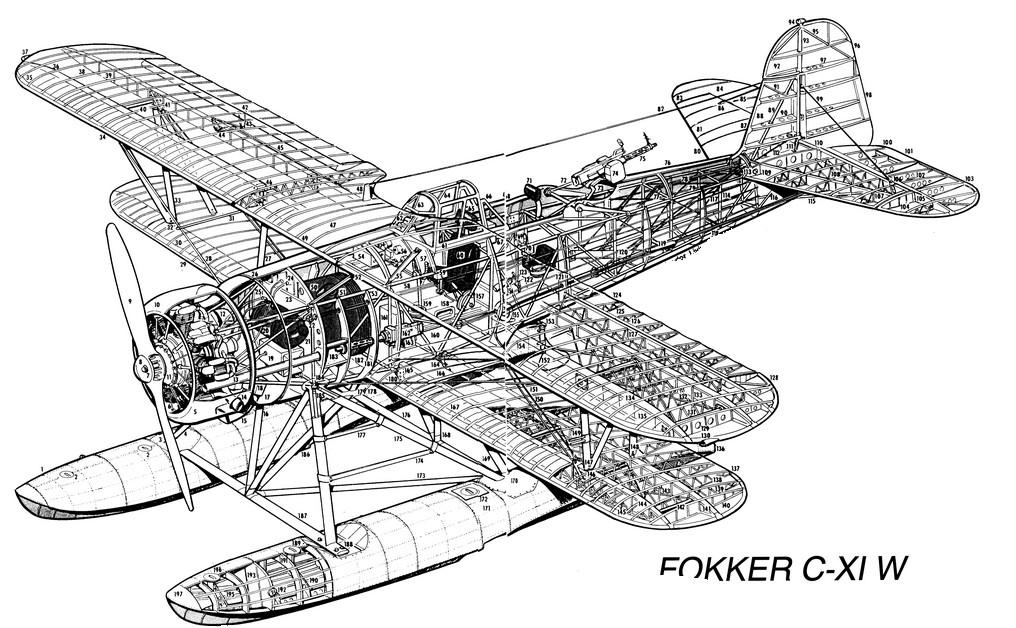
Cutaway of the Fokker C.11 w by Teodor Liviu Morosanu
The Fokker C.XI was very similar to the radial-powered C.X, resuing the same single-bay fuselage, seats arrangements, unequal size (sesquiplane) wings rounded tail and ailerons strut-supported fins. The Wingspan was more than 13 m (42 ft 8 in) for a fuselage lenght of 10.45 m (34 ft 1 in). On top of its two floats attached to the lower fuselage, it was 4.50 m (14 ft 9 in) tall. Its Empty weight was 1,720 kg, max takeoff weight 2,550 kg. It was made of mixed construction: The forward part of the fuselage was all-metal and cladded in aluminium, closing short of the forward seat, followed by a metallic framing wrapped in canvas. Same for the wings and fins, and the tail was wrapped in aluminium. The main structure was made of thin steel tubes.
The two floats were made of 22 frames, two used as bulkheads, and topped by four fillers. They were empty but could be used for storage for the crew’s personal stuff.
Engine and Performances
The engine chosen, instead of the Kestrel, was the American Wright Cyclone SR1820 radial engine, which developed 750 hp. This was far more than the Kestrel (650 kph), for the same space taken, enabling better performances for liftoff and combating the drag caused by the floats. The propeller was a wooden, two bladed fixed-pitch model. Max speed was 280 km/h and cruising speed 235 km/h, while flight range was 725 km, less however than the land-based C.X. It was aslso slow to take altitde, 2.4 min to reach 1,000 m (3,300 ft).
Armament
All of these had the same fixed, forward-firing 7.9 mm (.31 in) FN-Browning machine gun forward. It was completed by a rear trainable, rearward-firing 7.9 mm (.31 in) FN-Browning machine gun used by the observer from his open position. The ring had an interruptor at 0°, facing the tail.
The C.IX being used for reconnaissance, and already loaded by the two floats, it carried no bombs.
⚙ Fokker C.XI W specifications |
|
| Empty weight | 1,720 kg (3,792 lb) |
| Max weight | 2,550 kg (5,622 lb) |
| Fuselage lenght: | 10.40 m (34 ft 1 in) |
| Wingspan: | 13.00 m (42 ft 8 in) |
| Height: | 4.50 m (14 ft 9 in) |
| Wing Area: | 40.0 m2 (431 sq ft)2 |
| Propulsion | Wright R-1820-F25 , 578 kW (775 hp) |
| Top Speed | 280 km/h (170 mph, 150 kn) |
| Cruise Speed | 240 km/h (150 mph, 130 kn) |
| Climb Rate | 2.4 min to 1,000 m (3,300 ft) |
| Range | 670 km (420 mi, 360 nmi) |
| Ceiling | 6,400 m (21,000 ft) (Absolute ceiling 6,800 m (22,300 ft) |
| Armament | 1 Fwd 8mm FN MG, 1 flexible mt aft, same |
| Propeller | Two-bladed |
| Crew | 2: Pilot, Observer/gunner |
The Fokker C.IX in action
The C.XI may well have been the first Dutch aircraft to fire on a German aircraft.
By early 1937, the first batch of eight aircraft was later ported to seven, for a total of 15. They proved popular with the crews.
The L.V.A obtained its first five C-IXs with registration numbers 661 to 665 in 1937, remained in service until May 10, 1940, used at the time as target tugs for fighter pilots, air gunners and anti-aircraft artillery in each of the operational bases and then all were sent to the advanced training base in Haamstede, taking no part in combat. 661 under repair at Fokker was captured while the other were lost. One (#301) was sold to Switzerland and flew for a while as CH-176, escaping capture.
Accidents were frequent, in part due to its use onboard use, with at least two lost during hoisting on HNLMS Java and HNLMS Tromp, both lacking a catapult, and three aircraft due to fatal accidents, mostly crashes at sea. In March 1940, a proposal was made to Fokker to change the tabs on the vertical tail but it’s dubious it was done.
Squad exercises 1939:
The one operated aboard Hr.Ms. de Ruyter, Java and Tromp were together taking part in extensive exercises from 23 to 30 June 1939, all using a Fokker C.XI-W fpr reconnaissance and spotting. Hr.Ms. Kortenaer and Van Gent also took part in these squadron exercises, and planned to use the floatplane as well. Hr.Ms. Van Galen, Witte de With and Piet Hein plus the submarines K-IX, K-XI, K-XII, K-XV, K-XVI and K-XVII and the supply ship HrMs Zuiderkruis, tanker Juno also took part. Long range reconnaissance was provided bt three Dornier Do 24K.
WW2 combat, Netherlands
The three remaining in the Netherlands, W-3, W-9 and W-14 were assigned to Group Aircraft 3 based at NAS Vliegkamp Veere. Seven were listed organically, with four Fokker C.XIV-W. Before the German invasion W-9 was lost during a 13 April night flight, killing the crew. A Dornier 18 which landed to assist another Do 18 near Ameland, in international waters, derived due to the string current, drifting the shore of Ameland. It seems it had been shot down and forced to land by a C.XI-W whe encroaching Dutch air space. On 10 May 1940, W-3 was captured while repaired at the Mok, W-14 at Veere. For the ones fleeing to Britain (the next order was crated and shipped to the East Indies), and by June 30, 1940, Dutch Marine personnel and their planes were stationed in Calshot, UK, also with C.XIV-W aircraft carrying all necessary equipments and parts for the Dutch East Indies.
In the KNIL and against the Japanese (1941-42)
On 9 August 1940, six departed, followed by a shipment of C.XI-W and another C.XIV-W. They all met at Tandjong Priok by mid-October 1940. In the Dutch East Indies, one was deployed on Hr.Ms. Java, another on De Ruyter, both lost during the fights in 1942. It seems few of the Admiralen class destroyers did operate them. HrMs Tromp was later midufied in UK to British standards, and it is dubious that the cruiser ever operated the model after this.
The floatplanes shipped in crates to the East Indies were used by the KNIL. By December 1941, nine were still operational when the Japanese attacked, one lost prior. But losses were heavy. During the early 1942 invasion, they were all lost, the last burned to avoid capture by the Japanese.
Precise logs:
W-1 (5399) served both in the Netherlands and in the Dutch East Indies, it was destroyed on Lengkong Lake in 1942.
W-2 (5420) service mid-1937, served in the Netherlands as well as in the Dutch East Indies. Written off in January 1939 at Marine Vliegkamp Morokrembangang
W-3 (5421) service by 1938, served in the Netherlands. Destroyed during the bombing of De Mok naval air station 12-05-1940
W-4 (5422) Same. Destroyed at Marine Vliegkamp, lost at Morokrembangang 3/1/1942
W-5 (5423) Same. Served in the Netherlands as well as in the Dutch East Indies. Written off, same spot 5/1/1939
W-6 (5424) Same. Served in the Netherlands as well as in the Dutch East Indies. Crashed near the same 8/7/1940
W-7 (5425) Same and in Dutch East Indies from cruiser De Ruyter. Crashed near Blinjoe, off Banka north coast 26-09-1939
W-8 (5426) Same. Destroyed on Lengkong Lake, 3/2/1942
W-9 (5427) service mid-1937. Served in the Netherlands, notably at MVK Veere. Crashed off Kamperduin 13-04-1940
W-10 (5461) Served in the Netherlands 1937-38 as well as in the Dutch East Indies. Destroyed NAS Morokrembangang 02-03-1942
W-11 (5462) Served in the Netherlands and Dutch East Indies, destroyed on Lengkong Lake 02-03-1942
W-12 (5463) Served in the Netherlands & Dutch East Indies. Shot down over Tjepoe on 18-01-1942
W-13 (5464) Used in the Netherlands and KNIL, Lost unknown causes (accident) 18-01-1942
W-14 (5465) Service 1938. Fled to England in May 1940 then re-routed Dutch East Indies, destroyed on Lengkong Lake on 02-03-1942
W-15 (5466) same, served in the Netherlands and Dutch East Indies. Destroyed on Lengkong Lake on 02-03-1942
Illustrations
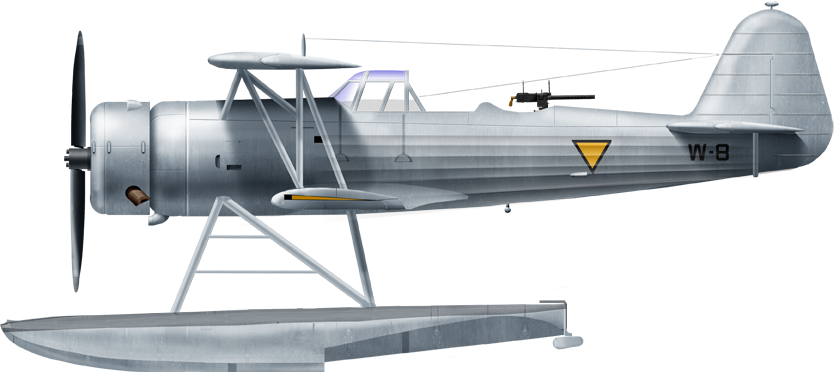
Fokker C.XI with KNIL Markings in 1935
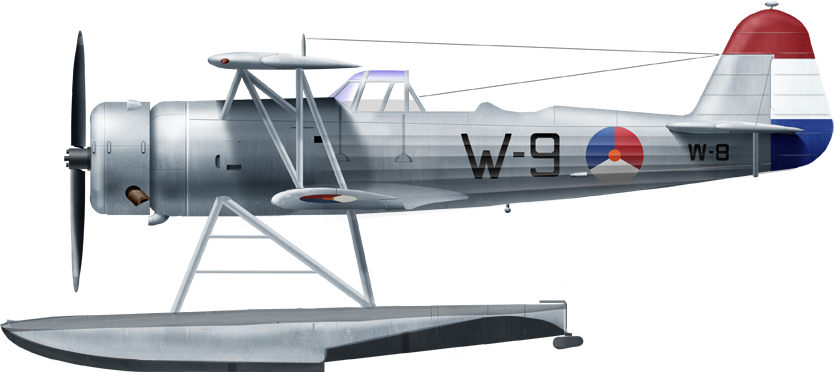
C.XI W with early national markings, Hr.Ms Java, east indies 1937

C.XI with high visibility markings, HMLNS De Ruyter, 1941
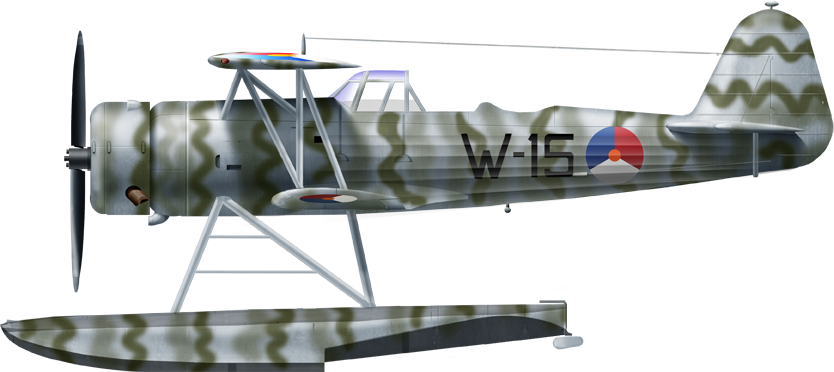
Surviving C.XI W camouflaged, Hr.Ms Java, east indies 1939
Gallery

Read More
Books
Green, William (1962). Warplanes of the Second World War: Volume Six, Floatplanes. London: Macdonald.
Hazewinkel, Harm J. (October 1979). “Fokker C-XIW”. Le fanatique de l’Aviation (in French). No. 119. pp. 26–31.
Taylor, Michael J. H. (1989). Jane’s Encyclopedia of Aviation. London: Studio Editions. p. 404.
World Aircraft Information Files. London: Bright Star Publishing. pp. File 894 Sheet 34.
Links
https://www.fokker-history.com/en-gb/c-xi-w
https://encyclopedia.pub/entry/33161
https://ipms.nl/artikelen/nedmil-luchtvaart/vliegtuigen-f/vliegtuigen-f-fokker-c11
http://www.airwar.ru/enc/sww2/fokc14.html
http://www.dutch-aviation.nl/index5/Military/index5-1%20C11w.html
https://www.fokker-history.com/en-gb/c-ix
https://en.wikipedia.org/wiki/Fokker_C.XI-W
https://nl.wikipedia.org/wiki/Fokker_C.IX
https://en.wikipedia.org/wiki/Fokker_C.V
https://war-book.ru/fokker-c-xi-razvedchik/
https://jmgrisnich.nl/2018/05/25/de-fokker-c-xi-w-1935-1942/
https://1000aircraftphotos.com/Contributions/deMoorJaap/10074.htm
Model Kits

MK Kits 1:72 Fokker C.XIw
See also the booklet
Videos


 Latest Facebook Entry -
Latest Facebook Entry -  X(Tweeter) Naval Encyclopedia's deck archive
X(Tweeter) Naval Encyclopedia's deck archive Instagram (@navalencyc)
Instagram (@navalencyc)





 French Navy
French Navy Royal Navy
Royal Navy Russian Navy
Russian Navy Armada Espanola
Armada Espanola Austrian Navy
Austrian Navy K.u.K. Kriegsmarine
K.u.K. Kriegsmarine Dansk Marine
Dansk Marine Nautiko Hellenon
Nautiko Hellenon Koninklije Marine 1870
Koninklije Marine 1870 Marinha do Brasil
Marinha do Brasil Osmanlı Donanması
Osmanlı Donanması Marina Do Peru
Marina Do Peru Marinha do Portugal
Marinha do Portugal Regia Marina 1870
Regia Marina 1870 Nihhon Kaigun 1870
Nihhon Kaigun 1870 Preußische Marine 1870
Preußische Marine 1870 Russkiy Flot 1870
Russkiy Flot 1870 Svenska marinen
Svenska marinen Søværnet
Søværnet Union Navy
Union Navy Confederate Navy
Confederate Navy Armada de Argentina
Armada de Argentina Imperial Chinese Navy
Imperial Chinese Navy Marinha do Portugal
Marinha do Portugal Mexico
Mexico Kaiserliche Marine
Kaiserliche Marine 1898 US Navy
1898 US Navy Sovietskiy Flot
Sovietskiy Flot Royal Canadian Navy
Royal Canadian Navy Royal Australian Navy
Royal Australian Navy RNZN Fleet
RNZN Fleet Chinese Navy 1937
Chinese Navy 1937 Kriegsmarine
Kriegsmarine Chilean Navy
Chilean Navy Danish Navy
Danish Navy Finnish Navy
Finnish Navy Hellenic Navy
Hellenic Navy Polish Navy
Polish Navy Romanian Navy
Romanian Navy Turkish Navy
Turkish Navy Royal Yugoslav Navy
Royal Yugoslav Navy Royal Thai Navy
Royal Thai Navy Minor Navies
Minor Navies Albania
Albania Austria
Austria Belgium
Belgium Columbia
Columbia Costa Rica
Costa Rica Cuba
Cuba Czechoslovakia
Czechoslovakia Dominican Republic
Dominican Republic Haiti
Haiti Hungary
Hungary Honduras
Honduras Estonia
Estonia Iceland
Iceland Eire
Eire Equador
Equador Iran
Iran Iraq
Iraq Latvia
Latvia Liberia
Liberia Lithuania
Lithuania Mandchukuo
Mandchukuo Morocco
Morocco Nicaragua
Nicaragua Persia
Persia San Salvador
San Salvador Sarawak
Sarawak Uruguay
Uruguay Venezuela
Venezuela Zanzibar
Zanzibar Warsaw Pact Navies
Warsaw Pact Navies Bulgaria
Bulgaria Hungary
Hungary

 Bundesmarine
Bundesmarine Dutch Navy
Dutch Navy Hellenic Navy
Hellenic Navy Marina Militare
Marina Militare Yugoslav Navy
Yugoslav Navy Chinese Navy
Chinese Navy Indian Navy
Indian Navy Indonesian Navy
Indonesian Navy JMSDF
JMSDF North Korean Navy
North Korean Navy Pakistani Navy
Pakistani Navy Philippines Navy
Philippines Navy ROKN
ROKN Rep. of Singapore Navy
Rep. of Singapore Navy Taiwanese Navy
Taiwanese Navy IDF Navy
IDF Navy Saudi Navy
Saudi Navy Royal New Zealand Navy
Royal New Zealand Navy Egyptian Navy
Egyptian Navy South African Navy
South African Navy






























 Ukrainian Navy
Ukrainian Navy dbodesign
dbodesign
Just a small correction, the D.VII was mentioned in the Armistice clauses, but not in the Versailles treaty.
Ok thanks, i revised the sentence.